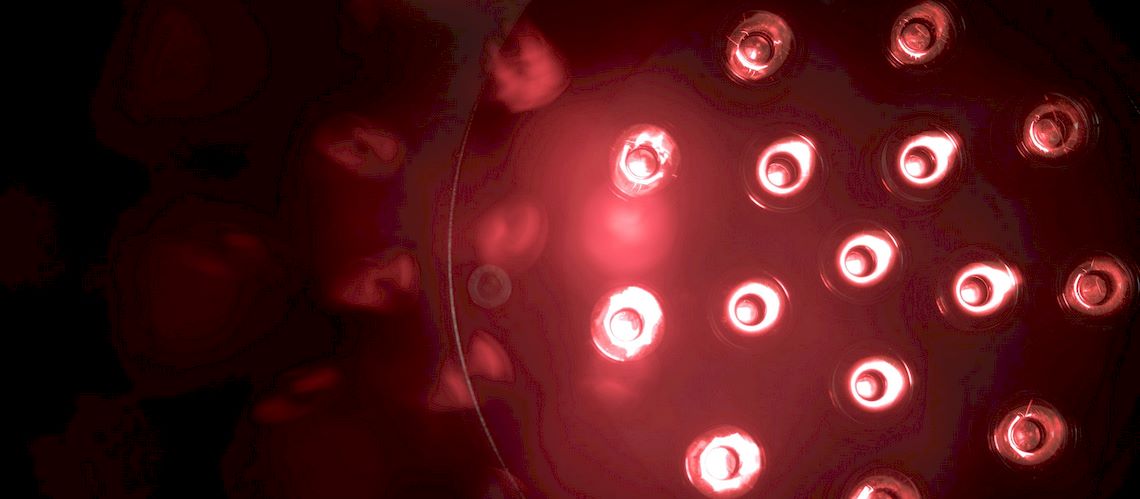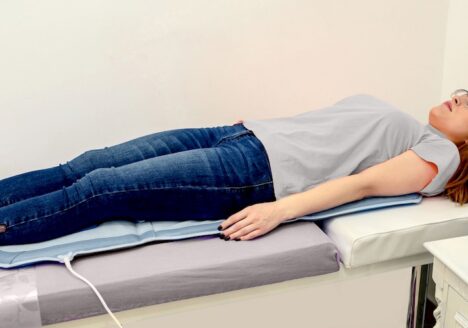Within the Excellence Nexus Framework, infrared light therapy (ILT) plays a crucial role in achieving Physical Peak. This therapy supports overall health, enhances physical performance, accelerates recovery, and reduces pain and inflammation. These attributes make ILT an essential component for individuals striving for excellence in their physical endeavors. Rooted in the principles of photobiomodulation, ILT uses infrared wavelengths to penetrate deep into tissues, stimulating cellular processes that promote healing, reduce inflammation, and optimize physical performance (Hamblin, 2017).
Application in the Excellence Nexus
Physical Peak
Infrared light therapy is integral to achieving Physical Peak by promoting cellular repair, reducing inflammation, and enhancing muscle recovery. These effects allow individuals to perform at their best by maintaining peak physical condition. Studies demonstrate that ILT can significantly reduce muscle soreness and accelerate recovery after intense physical activity, making it invaluable for athletes and fitness enthusiasts (Leal-Junior et al., 2013). Its role in supporting tissue repair and reducing oxidative stress further solidifies its importance in physical excellence.
Mental Peak
The physical benefits of ILT extend to Mental Peak by alleviating discomfort and pain that may otherwise hinder focus and cognitive performance. Improved physical health correlates with enhanced mental clarity and emotional stability, enabling individuals to achieve mental excellence. Research highlights that the reduction of chronic pain and inflammation achieved through ILT contributes to better mental well-being, indirectly supporting cognitive performance (Chow et al., 2009). For example, individuals with reduced physical discomfort often report better focus, memory, and problem-solving abilities, underscoring the interconnectedness of physical and mental vitality.
Emotional Peak
Relief from physical discomfort through ILT also enhances emotional well-being, supporting the attainment of Emotional Peak. Chronic pain and physical limitations often lead to emotional distress, including anxiety and depression. Effective pain management through ILT has been shown to improve mood and emotional balance significantly. By addressing these underlying issues, ILT fosters greater emotional resilience and a sense of well-being (Moro et al., 2017). This emotional stability allows individuals to better manage stress and engage with life’s challenges.
Spiritual Peak
Physical vitality plays a pivotal role in supporting Spiritual Peak by enabling deeper engagement in practices that require focus, energy, and mindfulness. A healthy and pain-free body allows individuals to dedicate themselves fully to activities such as meditation and reflective practices. ILT’s ability to reduce physical discomfort and promote vitality fosters a balanced state conducive to spiritual growth, aligning with the broader goals of the Excellence Nexus (Hamblin, 2017).
Prosperity Peak
Enhanced physical health contributes to greater productivity and efficiency, aligning with Prosperity Peak. By reducing pain and improving recovery times, ILT helps individuals maintain consistent performance in professional and personal domains. Fewer missed workdays and increased physical and mental energy translate into greater success and prosperity over time. For those pursuing high levels of achievement, ILT ensures that physical vitality supports long-term growth and productivity (Chung et al., 2012).
Impact Peak
The vitality gained from ILT empowers individuals to contribute more effectively to their communities and make a lasting impact. Enhanced physical and mental well-being enables individuals to take on leadership roles, engage in meaningful projects, and sustain efforts to benefit others. ILT’s ability to support consistent energy levels ensures individuals can maximize their influence and create enduring legacies, aligning with Impact Peak (Leal-Junior et al., 2013).
Benefits within the Excellence Nexus
The integration of ILT within the Excellence Nexus Framework offers multiple benefits across all peaks:
- Enhanced Physical Performance and Recovery: ILT improves circulation, reduces muscle fatigue, and accelerates recovery, making it an essential tool for achieving peak physical performance (Leal-Junior et al., 2013).
- Reduced Pain and Inflammation: ILT effectively alleviates pain and inflammation in various conditions, providing a powerful non-invasive solution for chronic pain management and sustained physical function (Chow et al., 2009; Baroni et al., 2010).
- Improved Overall Health and Vitality: By supporting cellular repair and reducing oxidative stress, ILT enhances physical and mental energy, contributing to sustained excellence across multiple life domains (Hamblin, 2017).
- Synergistic Support for Peak Performance: The combined physical, mental, and emotional benefits of ILT enable individuals to excel in professional, personal, and social contexts, aligning with the Excellence Nexus’s vision of holistic achievement (Chung et al., 2012).
How to Integrate Infrared Light Therapy in the Excellence Nexus
Assessment
Evaluate your health and performance goals to identify areas where ILT can provide the most benefit. This may involve consulting healthcare professionals to address specific needs such as chronic pain, recovery enhancement, or physical optimization (Hamblin, 2017). Identifying the right application for ILT ensures its effectiveness within your personalized wellness strategy.
Implementation
Incorporate regular ILT sessions into your routine as part of a broader strategy to achieve peak performance. Daily sessions of 10–20 minutes are recommended, with adjustments based on individual goals. Selecting devices that emit light in the therapeutic range of 700–1000 nm ensures effective outcomes (Leal-Junior et al., 2013). Pairing ILT with complementary practices such as proper nutrition, exercise, and recovery strategies will maximize its benefits.
Optimization
Monitor your progress over time to ensure that ILT is effectively supporting your goals. This includes tracking metrics like recovery times, pain levels, and overall physical performance. Adjust the frequency and intensity of ILT sessions based on observed results to optimize its impact on your Physical Peak and other areas of excellence. For example, an athlete using ILT for post-exercise recovery might observe reduced muscle soreness over weeks and adjust session duration to further enhance results (Hamblin, 2017).
Conclusion
Infrared light therapy is an indispensable tool within the Excellence Nexus Framework for achieving Physical Peak. Its scientifically validated benefits—enhanced recovery, reduced pain, and improved physical performance—make it a cornerstone of a holistic strategy for excellence. By incorporating ILT into your routine, you can unlock new levels of physical, mental, and emotional potential, paving the way for success across all areas of life. ILT embodies the Excellence Nexus’s mission to empower individuals to reach their highest peaks and make a meaningful impact in their personal and professional lives.
References
- Baroni, B.M., Leal Junior, E.C.P., De Marchi, T., Lopes, A.L., and Salvador, M. (2010) ‘Low-level laser therapy before eccentric exercise reduces muscle damage markers in humans’, European Journal of Applied Physiology, 110(4), pp. 789–796.
- Chow, R.T., Johnson, M.I., Lopes-Martins, R.A., and Bjordal, J.M. (2009) ‘Efficacy of low-level laser therapy in the management of neck pain: a systematic review and meta-analysis of randomised placebo or active-treatment controlled trials’, Database of Abstracts of Reviews of Effects (DARE): Quality-assessed Reviews [Internet]. Centre for Reviews and Dissemination (UK). Available at: https://www.ncbi.nlm.nih.gov/books/NBK78464/.
- Chung, H., Dai, T., Sharma, S.K., Huang, Y.-Y., Carroll, J.D., and Hamblin, M.R. (2012) ‘The nuts and bolts of low-level laser (light) therapy’, Annals of Biomedical Engineering, 40(2), pp. 516–533.
- Cotler, H.B., Chow, R.T., Hamblin, M.R., and Carroll, J. (2015) ‘The use of low-level laser therapy (LLLT) for musculoskeletal pain’, MOJ Orthopedics & Rheumatology, 2(5), p. 00068.
- Hamblin, M.R., and Demidova, T.N. (2006) ‘Mechanisms of low-level light therapy’, Proceedings of SPIE, 6140, pp. 1–12.
- Hamblin, M.R. (2016) ‘Shining light on the head: photobiomodulation for brain disorders’, BBA Clinical, 6, pp. 113–124.
- Hamblin, M.R. (2017) ‘Mechanisms and applications of the anti-inflammatory effects of photobiomodulation’, AIMS Biophysics, 4(3), pp. 337–361.
- Leal-Junior, E.C.P., Lopes-Martins, R.A., and Bjordal, J.M. (2015) ‘Effect of phototherapy (low-level laser therapy and light-emitting diode therapy) on exercise performance and markers of exercise recovery: a systematic review with meta-analysis’, Lasers in Medical Science, 30(2), pp. 925–939.
- McDonagh, A.F. (2001) ‘Phototherapy: From Ancient Egypt to the New Millennium’, Journal of Perinatology, 21(S1), pp. S7–S12.
- Posten, W., Wrone, D.A., Dover, J.S., Arndt, K.A., Silapunt, S., and Alam, M. (2005) ‘Low-level laser therapy for wound healing: mechanism and efficacy’, Dermatologic Surgery, 31(3), pp. 334–340.
- Ruh, A.C., Frade, M.A.C., Bagnato, V.S., and Kurachi, C. (2018) ‘Laser photobiomodulation in pressure ulcer healing of human diabetic patients: gene expression analysis of inflammatory biochemical markers’, Lasers in Medical Science, 33(1), pp. 165–171.
- Whelan, H.T., Smits, R.L., Buchmann, E.V., Whelan, N.T., Turner, S.G., Margolis, D.A., Cevenini, V., Stinson, H., Ignatius, R., Martin, T., and Cwiklinski, J. (2003) ‘Effect of NASA light-emitting diode irradiation on molecular changes for wound healing in diabetic mice’, Journal of Clinical Laser Medicine & Surgery, 21(2), pp. 67–74.




